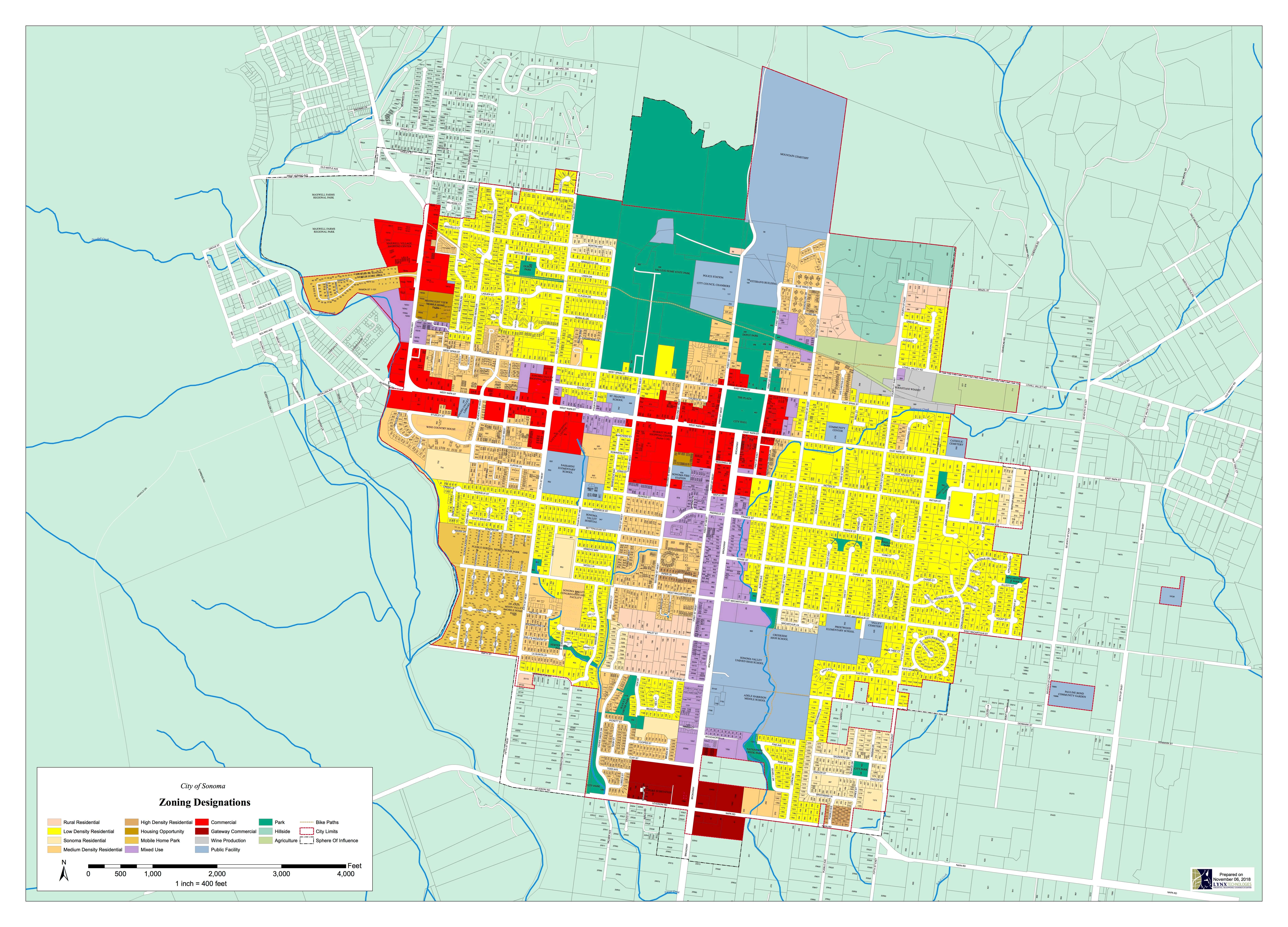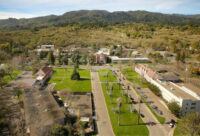Part of the General Plan 2045 update that is currently taking place in the City of Sonoma includes consideration of changing land uses.
The city’s General Plan dictates what type of land uses are allowed on every parcel of land within the city’s limits. Changes in land use carry with them the potential for big change. The Sebastiani Winery property on 4th Street East, comprising over twenty acres, may be modified, for example, for a mix of housing and commercial uses.
First, some background on zoning and land use regulation.
The City of Sonoma, like all governmental jurisdictions, regulates how property can be used, not who can own it. Accordingly, land parcels in the city are owned privately by individuals and businesses, and publicly by the government, such as parks, cemeteries, and government building locations.
The city uses a number of land use and zoning designations: commercial, residential, mixed use, gateway, public, park, agricultural, and more. In some cases, the zoning is so consistent that areas of the city can be described as districts. The Plaza, for example, is zoned commercial, and comprises one “district.” Moreover, the city has created what it calls “overlay zones.” Overlay zones apply development and use regulations not by parcel, but by area.
Residential zoning is divided between several types: Low Density (Generally Single family Homes), Medium Density (Multi-family housing), High Density (apartments), and Housing Opportunity (intended for Affordable Housing). Detailed development standards covering height, maximum size, and so forth are associated with each of these zones.
Zoning is intended to regulate uses so that areas of the city remain consistent and not haphazard. For example, the commercial use of a residentially zoned parcel is not allowed. Such uses could include charging the public for the repairing of autos or trucks, or operating a bed and breakfast inn open to the public without a permit. In some cases, zoning is intended to protect the public health and welfare, and in others to maintain the use characteristics of a neighborhood.
When it comes to the regulation of housing, the State of California has usurped local authority from cities and counties over the past several years, passing state-wide legislation that has fundamentally changed how cities can regulate housing development, and even overriding the intent and implementation of local zoning.
In 2023 the State of California passed 53 pieces of housing legislation, and that pace has continued in 2024.
Among the regulations passed by the state are ones that require development standards in Zoning Codes to be “objective” rather than “subjective.” Development standards, as noted, typically dictate matters such as size, height, and mass. Historically, decision-making and permit approval also allowed consideration of character; compatibility, neighborhood context, historical patterns and aesthetic considerations were all acceptable criteria in evaluating development applications. Such considerations have now been deemed unacceptable by the State of California, which considers them too subjective and prone to interpretation. Decisions must now be based on objective, quantifiable standards only. The re-writing of the General Plan includes removing all subjective standards.
Against this backdrop the city’s General Plan revision has now reached the stage at which consideration is being given to modifying land uses. The Planning Commission, a body made up of seven appointees of the City Council, recently reviewed changing the land uses of three parcels in town: the Sebastiani Winery on Fourth Street East, the First Congregational Church on West Spain Street, and two parcels on Napa Road – numbers 200 and 250. Additional requests for land use changes may be submitted going forward.
The Sebastiani Winery is presently owned by Foley Family wines, which acquired the property in 2008. It has since shuttered all but the tasting room, and no winemaking production takes place on the site now occupied by empty offices, warehouses, and production facilities.
In a letter to the Planning Commission, J.J. Abodeely, Mark Mance and Kelso Barnett noted the historic value of the Sebastiani Winery site and the need for careful consideration of its future. Mr. Abodeely has been meeting privately with City Council and Planning Commission members to explore development options, including the idea of including a resort hotel in addition to housing and wine tasting on the twenty-plus acres. Mr. Mance is the founder of the Northview Hotel Group. Mr. Barnett, a former City Council member, is part of the development group that just received city approval for the multi-unit housing project located on First Street East, across from the Little League ball fields on a parcel formerly owned by Peterson Mechanical.
The First Congregational Church wants to change its zoning from Low-Density Residential to allow the development of Affordable Housing on its parcel. The church would be moved on-site, and the older existing buildings replaced. From 40-50 units could be allowed under the proposed land use designation.
The parcels on Napa Road are mostly undeveloped; a commercial use on one parcel abutting the lumber yard at Friedman Brothers previously existed, but the other parcel is tree-covered. Both parcels straddle Nathanson Creek, and the mandated creek setbacks limit the intensity and type of development that can take place. It is currently zoned Medium Density Residential and might change to Gateway Commercial. The property owner wants to look at a land use change to make it possible to develop or sell the parcels as commercial or residential.
The General Plan update process begins with the Planning Commission, but ultimately the final decision rests with the City Council, which must approve any changes in the land-use of the city. Any proposed land use changes would be analyzed under CEQA, the California Environmental QualityAct. After adoption of the General Plan, the city would consider the rezoning of those parcels and any other zoning code changes required to implement the updated General Plan.
by Larry Barnett
Larry Barnett is the Chair of Sonoma’s Planning Commission, and the Executive Director of the Sonoma Valley Sun newspaper.






excellent presentation and explanation of the multi faceted,
Jurisdictional, complications involved in crafting a balanced City Plan. No easy task and I wish you all every success.
I am a former Sonoma Valley Resident and as such both the city of Sonoma and the Valley of the Moon continue to hold a special place in my heart and memories.
Is traffic a consideration in making these decisions? The traffic on West Spain Street is already overwhelming with its entrance to the Sonoma Plaza and the hundreds (thousands?) who use it as a preference to traveling on Napa St/Hwy 12. How would 40-50 new units ( with up to 100 new automobiles) built on the Congregational Church site fare with the existing traffic? When can citizens get more information on these proposals as well as information on exactly how final decisions are made? Thank you.
The site of the Sebastiani winery is in jeopardy of being re-developed in a way that won’t further affordable housing. It COULD be a residential/commercial (and transit!*) hub with affordable housing.